
Big O Notation and Time Complexity – Easily Explained
The big O notation¹ is used to describe the complexity of algorithms.
On Google and YouTube, you can find numerous articles and videos explaining the big O notation. But to understand most of them (like this Wikipedia article), you should have studied mathematics as a preparation. ;-)
That' s why, in this article, I will explain the big O notation (and the time and space complexity described with it) only using examples and diagrams – and entirely without mathematical formulas, proofs and symbols like θ, Ω, ω, ∈, ∀, ∃ and ε.
You can find all source codes from this article in this GitHub repository.
¹ also known as "Bachmann-Landau notation" or "asymptotic notation"
Types of Complexity
Computational Time Complexity
Computational time complexity describes the change in the runtime of an algorithm, depending on the change in the input data's size.
In other words: "How much does an algorithm degrade when the amount of input data increases?"
Examples:
- How much longer does it take to find an element within an unsorted array when the size of the array doubles? (Answer: twice as long)
- How much longer does it take to find an element within a sorted array when the size of the array doubles? (Answer: one more step)
Space Complexity
Space complexity describes how much additional memory an algorithm needs depending on the size of the input data.
This does not refer to the memory required for the input data itself (i.e., that twice as much space is naturally needed for an input array twice as large), but the additional memory needed by the algorithm for loop and helper variables, temporary data structures, and the call stack (e.g., due to recursion).
Complexity Classes
We divide algorithms into so-called complexity classes. A complexity class is identified by the Landau symbol O ("big O").
In the following section, I will explain the most common complexity classes, starting with the easy-to-understand classes and moving on to the more complex ones. Accordingly, the classes are not sorted by complexity.
O(1) – Constant Time
Pronounced: "Order 1", "O of 1", "big O of 1"
The runtime is constant, i.e., independent of the number of input elements n.
In the following graph, the horizontal axis represents the number of input elements n (or more generally: the size of the input problem), and the vertical axis represents the time required.
Since complexity classes can only be used to classify algorithms, but not to calculate their exact running time, the axes are not labeled.

O(1) Examples
The following two problems are examples of constant time:
- Accessing a specific element of an array of size n: No matter how large the array is, accessing it via
array[index]always takes the same time². - Inserting an element at the beginning of a linked list: This always requires setting one or two (for a doubly linked list) pointers (or references), regardless of the list's size. (In an array, on the other hand, this would require moving all values one field to the right, which takes longer with a larger array than with a smaller one).
² This statement is not one hundred percent correct. Effects from CPU caches also come into play here: If the data block containing the element to be read is already (or still) in the CPU cache (which is more likely the smaller the array is), then access is faster than if it first has to be read from RAM.
O(1) Example Source Code
The following source code (class ConstantTimeSimpleDemo in the GitHub repository) shows a simple example to measure the time required to insert an element at the beginning of a linked list:
public static void main(String[] args) {
for (int n = 32; n <= 8_388_608; n *= 2) {
LinkedList<Integer> list = createLinkedListOfSize(n);
long time = System.nanoTime();
list.add(0, 1);
time = System.nanoTime() - time;
System.out.printf("n = %d -> time = %d ns%n", n, time);
}
}
private static LinkedList<Integer> createLinkedListOfSize(int n) {
LinkedList<Integer> list = new LinkedList<>();
for (int i = 0; i < n; i++) {
list.add(i);
}
return list;
}Code language: Java (java)On my system, the times are between 1,200 ns and 19,000 ns, unevenly distributed over the various measurements. This is sufficient for a quick test. But we don't get particularly good measurement results here, as both the HotSpot compiler and the garbage collector can kick in at any time.
The test program TimeComplexityDemo with the ConstantTime class provides better measurement results. The test program first runs several warmup rounds to allow the HotSpot compiler to optimize the code. Only after that are measurements performed five times, and the median of the measured values is displayed.
Here is an extract of the results:
--- ConstantTime (results 5 of 5) ---
ConstantTime, n = 32 -> fastest: 31,700 ns, median: 44,900 ns
ConstantTime, n = 16,384 -> fastest: 14,400 ns, median: 40,200 ns
ConstantTime, n = 8,388,608 -> fastest: 34,000 ns, median: 51,100 nsCode language: plaintext (plaintext)The effort remains about the same, regardless of the size of the list. The complete test results can be found in the file test-results.txt.
O(n) – Linear Time
Pronounced: "Order n", "O of n", "big O of n"
The time grows linearly with the number of input elements n: If n doubles, then the time approximately doubles, too.
"Approximately" because the effort may also include components with lower complexity classes. These become insignificant if n is sufficiently large so they are omitted in the notation.
In the following diagram, I have demonstrated this by starting the graph slightly above zero (meaning that the effort also contains a constant component):
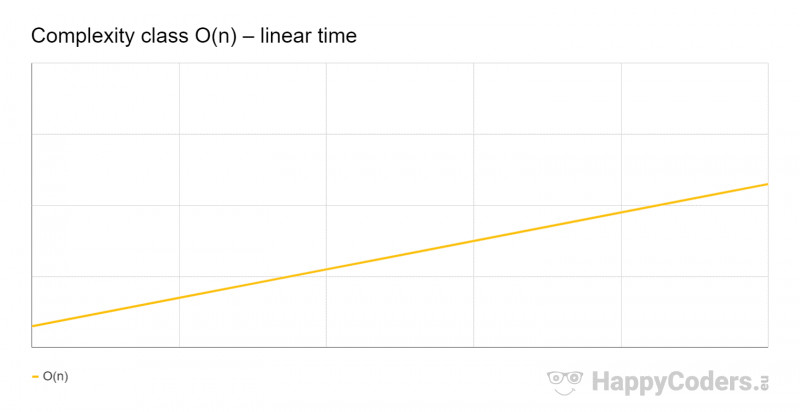
O(n) Examples
The following problems are examples for linear time:
- Finding a specific element in an array: All elements of the array have to be examined – if there are twice as many elements, it takes twice as long.
- Summing up all elements of an array: Again, all elements must be looked at once – if the array is twice as large, it takes twice as long.
It is essential to understand that the complexity class makes no statement about the absolute time required, but only about the change in the time required depending on the change in the input size. The two examples above would take much longer with a linked list than with an array – but that is irrelevant for the complexity class.
O(n) Example Source Code
The following source code (class LinearTimeSimpleDemo) measures the time for summing up all elements of an array:
public static void main(String[] args) {
for (int n = 32; n <= 536_870_912; n *= 2) {
int[] array = createArrayOfSize(n);
long sum = 0;
long time = System.nanoTime();
for (int i = 0; i < n; i++) {
sum += array[i];
}
time = System.nanoTime() - time;
System.out.printf("n = %d -> time = %d ns%n", n, time);
}
}
private static int[] createArrayOfSize(int n) {
int[] array = new int[n];
for (int i = 0; i < n; i++) {
array[i] = i;
}
return array;
}
Code language: Java (java)On my system, the time degrades approximately linearly from 1,100 ns to 155,911,900 ns. Better measurement results are again provided by the test program TimeComplexityDemo and the LinearTime algorithm class. Here is an extract of the results:
--- LinearTime (results 5 of 5) ---
LinearTime, n = 512 -> fastest: 300 ns, median: 300 ns
LinearTime, n = 524,288 -> fastest: 159,300 ns, median: 189,400 ns
LinearTime, n = 536,870,912 -> fastest: 164,322,600 ns, median: 168,681,700 nsCode language: plaintext (plaintext)You can find the complete test results again in test-results.txt.
What is the Difference Between "Linear" and "Proportional"?
A function is linear if it can be represented by a straight line, e.g. f(x) = 5x + 3.
Proportional is a particular case of linear, where the line passes through the point (0,0) of the coordinate system, for example, f(x) = 3x.
As there may be a constant component in O(n), it's time is linear.
O(n²) – Quadratic Time
Pronounced: "Order n squared", "O of n squared", "big O of n squared"
The time grows linearly to the square of the number of input elements: If the number of input elements n doubles, then the time roughly quadruples. (And if the number of elements increases tenfold, the effort increases by a factor of one hundred!)

O(n²) Examples
Examples of quadratic time are simple sorting algorithms like Insertion Sort, Selection Sort, and Bubble Sort.
O(n²) Example Source Code
The following example (QuadraticTimeSimpleDemo) shows how the time for sorting an array using Insertion Sort changes depending on the size of the array:
public static void main(String[] args) {
for (int n = 32; n <= 262_144; n *= 2) {
int[] array = createRandomArrayOfSize(n);
long time = System.nanoTime();
insertionSort(array);
time = System.nanoTime() - time;
System.out.printf("n = %d -> time = %d ns%n", n, time);
}
}
private static int[] createRandomArrayOfSize(int n) {
ThreadLocalRandom random = ThreadLocalRandom.current();
int[] array = new int[n];
for (int i = 0; i < n; i++) {
array[i] = random.nextInt();
}
return array;
}
private static void insertionSort(int[] elements) {
for (int i = 1; i < elements.length; i++) {
int elementToSort = elements[i];
int j = i;
while (j > 0 && elementToSort < elements[j - 1]) {
elements[j] = elements[j - 1];
j--;
}
elements[j] = elementToSort;
}
}
Code language: Java (java)We can obtain better results with the test program TimeComplexityDemo and the QuadraticTime class. Here is an excerpt of the results, where you can see the approximate quadrupling of the effort each time the problem size doubles:
QuadraticTime, n = 8,192 -> fastest: 4,648,400 ns, median: 4,720,200 ns
QuadraticTime, n = 16,384 -> fastest: 19,189,100 ns, median: 19,440,400 ns
QuadraticTime, n = 32,768 -> fastest: 78,416,700 ns, median: 79,896,000 ns
QuadraticTime, n = 65,536 -> fastest: 319,905,300 ns, median: 330,530,600 ns
QuadraticTime, n = 131,072 -> fastest: 1,310,702,600 ns, median: 1,323,919,500 nsCode language: plaintext (plaintext)You can find the complete test results in test-results.txt.
O(n) vs. O(n²)
At this point, I would like to point out again that the effort can contain components of lower complexity classes and constant factors. Both are irrelevant for the big O notation since they are no longer of importance if n is sufficiently large.
It is therefore possible that, for example, O(n²) is faster than O(n) – at least up to a certain size of n.
The following diagram compares three fictitious algorithms: one with complexity class O(n²) and two with O(n), one of which is faster than the other. It is good to see how up to n = 4, the orange O(n²) algorithm takes less time than the yellow O(n) algorithm. And even up to n = 8, less time than the cyan O(n) algorithm.
Above a sufficiently large n (that is n = 9), O(n²) is and remains the slowest algorithm.
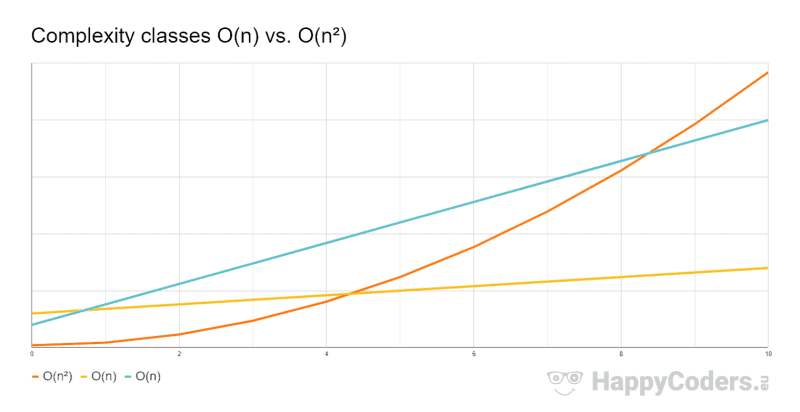
Let's move on to two, not-so-intuitive complexity classes.
O(log n) – Logarithmic Time
Pronounced: "Order log n", "O of log n", "big O of log n"
The effort increases approximately by a constant amount when the number of input elements doubles.
For example, if the time increases by one second when the number of input elements increases from 1,000 to 2,000, it only increases by another second when the effort increases to 4,000. And again by one more second when the effort grows to 8,000.
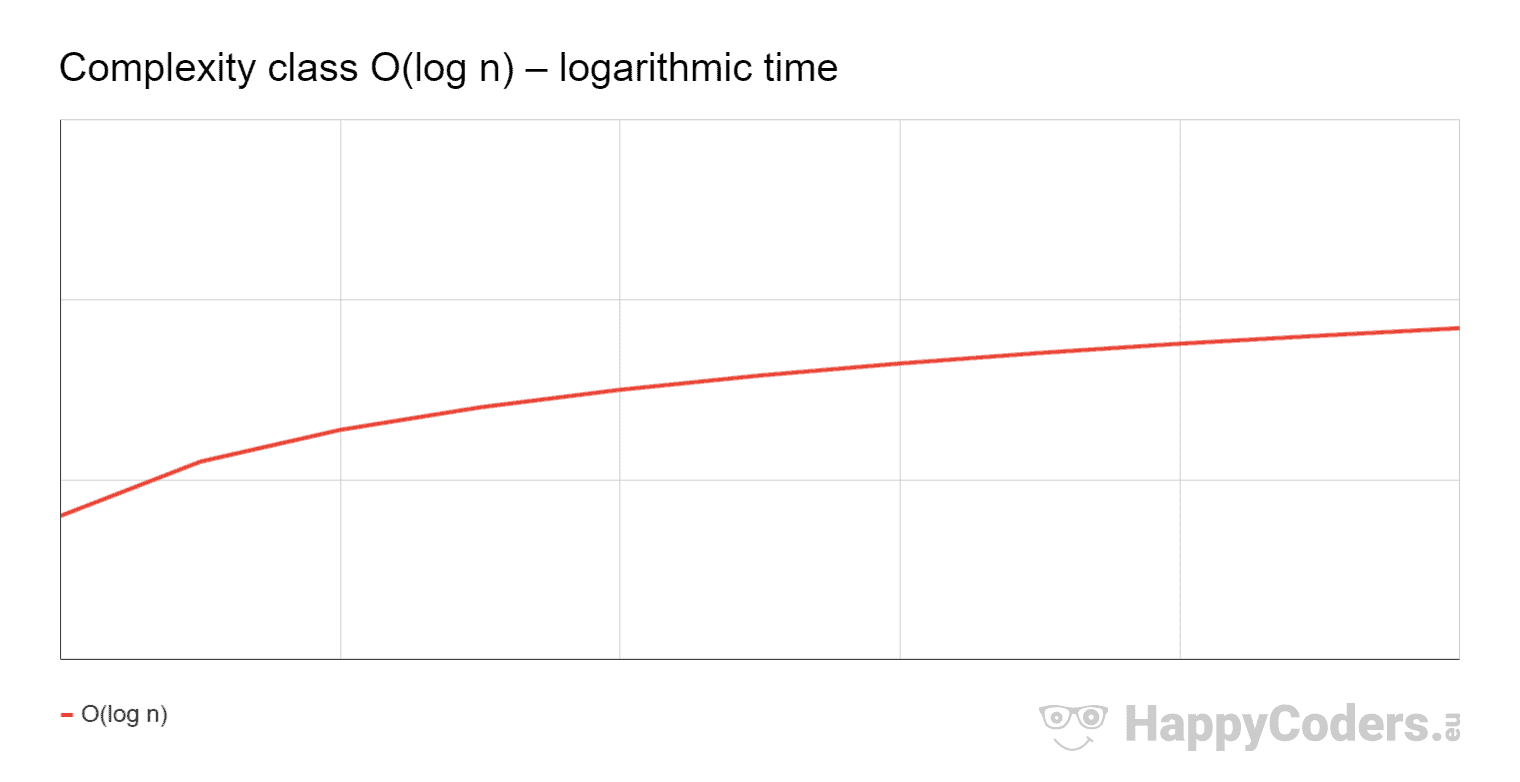
O(log n) Example
An example of logarithmic growth is the binary search for a specific element in a sorted array of size n.
Since we halve the area to be searched with each search step, we can, in turn, search an array twice as large with only one more search step.
(The older ones among us may remember searching the telephone book or an encyclopedia.)
O(log n) Example Source Code
The following example (LogarithmicTimeSimpleDemo) measures how the time for binary search changes in relation to the array size.
public static void main(String[] args) {
for (int n = 32; n <= 536_870_912; n *= 2) {
int[] array = createArrayOfSize(n);
long time = System.nanoTime();
Arrays.binarySearch(array, 0);
time = System.nanoTime() - time;
System.out.printf("n = %d -> time = %d ns%n", n, time);
}
}
private static int[] createArrayOfSize(int n) {
int[] array = new int[n];
for (int i = 0; i < n; i++) {
array[i] = i;
}
return array;
}Code language: Java (java)We get better measurement results with the test program TimeComplexityDemo and the class LogarithmicTime. Here are the results:
LogarithmicTime, n = 32 -> fastest: 77,800 ns, median: 107,200 ns
LogarithmicTime, n = 2,048 -> fastest: 173,500 ns, median: 257,400 ns
LogarithmicTime, n = 131,072 -> fastest: 363,400 ns, median: 413,100 ns
LogarithmicTime, n = 8,388,608 -> fastest: 661,100 ns, median: 670,800 ns
LogarithmicTime, n = 536,870,912 -> fastest: 770,500 ns, median: 875,700 nsCode language: plaintext (plaintext)In each step, the problem size n increases by factor 64. The time does not always increase by exactly the same value, but it does so sufficiently precisely to demonstrate that logarithmic time is significantly cheaper than linear time (for which the time required would also increase by factor 64 each step).
As before, you can find the complete test results in the file test-results.txt.
O(n log n) – Quasilinear Time
Pronounced: "Order n log n", "O of n log n", "big O of n log n"
The effort grows slightly faster than linear because the linear component is multiplied by a logarithmic one. For clarification, you can also insert a multiplication sign: O(n × log n).
This is best illustrated by the following graph. We see a curve whose gradient is visibly growing at the beginning, but soon approaches a straight line as n increases:
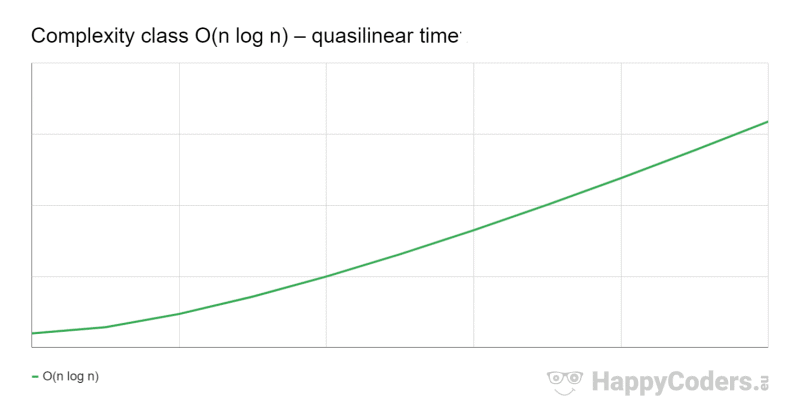
O(n log n) Example
Efficient sorting algorithms like Quicksort, Merge Sort, and Heapsort are examples for quasilinear time.
O(n log n) Example Source Code
The following sample code (class QuasiLinearTimeSimpleDemo) shows how the time for sorting an array with Quicksort³ grows in relation to the array size:
public static void main(String[] args) {
for (int n = 32; n <= 536_870_912; n *= 2) {
int[] array = createArrayOfSize(n);
long time = System.nanoTime();
Arrays.binarySearch(array, 0);
time = System.nanoTime() - time;
System.out.printf("n = %d -> time = %d ns%n", n, time);
}
}
private static int[] createArrayOfSize(int n) {
int[] array = new int[n];
for (int i = 0; i < n; i++) {
array[i] = i;
}
return array;
}Code language: Java (java)The test program TimeComplexityDemo with the class QuasiLinearTime delivers more precise results. Here is an extract:
QuasiLinearTime, n = 256 -> fastest: 12,200 ns, med.: 12,500 ns
QuasiLinearTime, n = 4,096 -> fastest: 228,600 ns, med.: 234,200 ns
QuasiLinearTime, n = 65,536 -> fastest: 4,606,500 ns, med.: 4,679,800 ns
QuasiLinearTime, n = 1,048,576 -> fastest: 93,933,500 ns, med.: 95,216,300 ns
QuasiLinearTime, n = 16,777,216 -> fastest: 1,714,541,900 ns, med.: 1,755,715,000 nsCode language: plaintext (plaintext)The problem size increases each time by factor 16, and the time required by factor 18.5 to 20.3. You can find the complete test result, as always, in test-results.txt.
³ More precisely: Dual-Pivot Quicksort, which switches to Insertion Sort for arrays with less than 44 elements. For this reason, this test starts at 64 elements, not at 32 like the others.
Big O Notation Order
Here are, once again, the complexity classes, sorted in ascending order of complexity:
- O(1) – constant time
- O(log n) – logarithmic time
- O(n) – linear time
- O(n log n) – quasilinear time
- O(n²) – quadratic time
And here the comparison graphically:
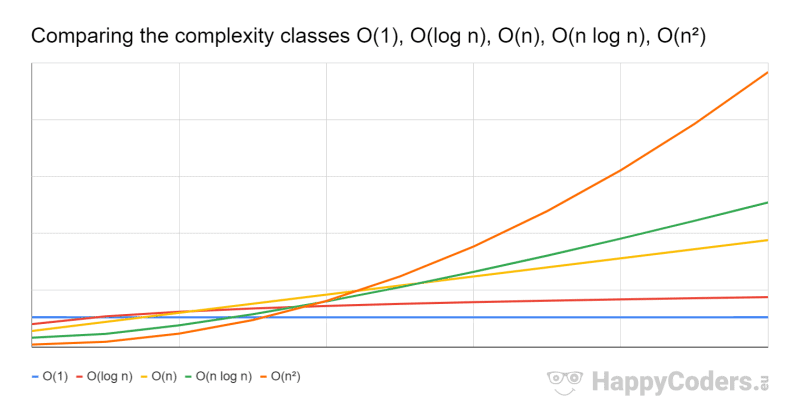
I intentionally shifted the curves along the time axis so that the worst complexity class O(n²) is fastest for low values of n, and the best complexity class O(1) is slowest. To then show how, for sufficiently high values of n, the efforts shift as expected.
Other Complexity Classes
Further complexity classes are, for example:
- O(nm) – polynomial time
- O(2n) – exponential time
- O(n!) – factorial time
However, these are so bad that we should avoid algorithms with these complexities, if possible.
I have included these classes in the following diagram (O(nm) with m=3):
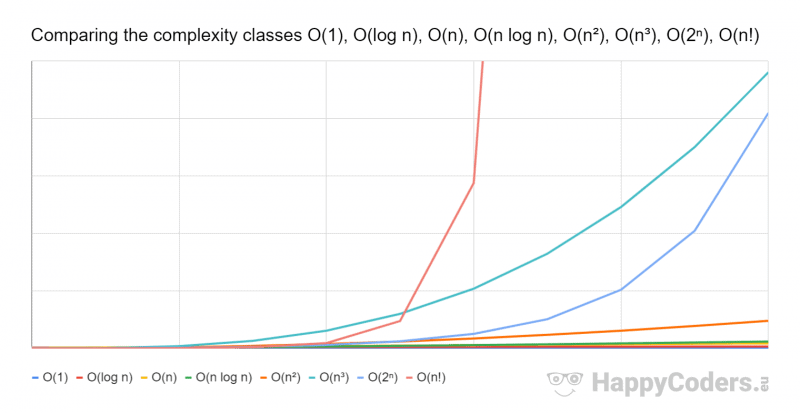
I had to compress the y-axis by factor 10 compared to the previous diagram to display the three new curves.
Summary
Time complexity describes how the runtime of an algorithm changes depending on the amount of input data. The most common complexity classes are (in ascending order of complexity): O(1), O(log n), O(n), O(n log n), O(n²).
Algorithms with constant, logarithmic, linear, and quasilinear time usually lead to an end in a reasonable time for input sizes up to several billion elements. Algorithms with quadratic time can quickly reach theoretical execution times of several years for the same problem sizes⁴. You should, therefore, avoid them as far as possible.
⁴ Quicksort, for example, sorts a billion items in 90 seconds on my laptop; Insertion Sort, on the other hand, needs 85 seconds for a million items; that would be 85 million seconds for a billion items – or in other words: two years and eight months!